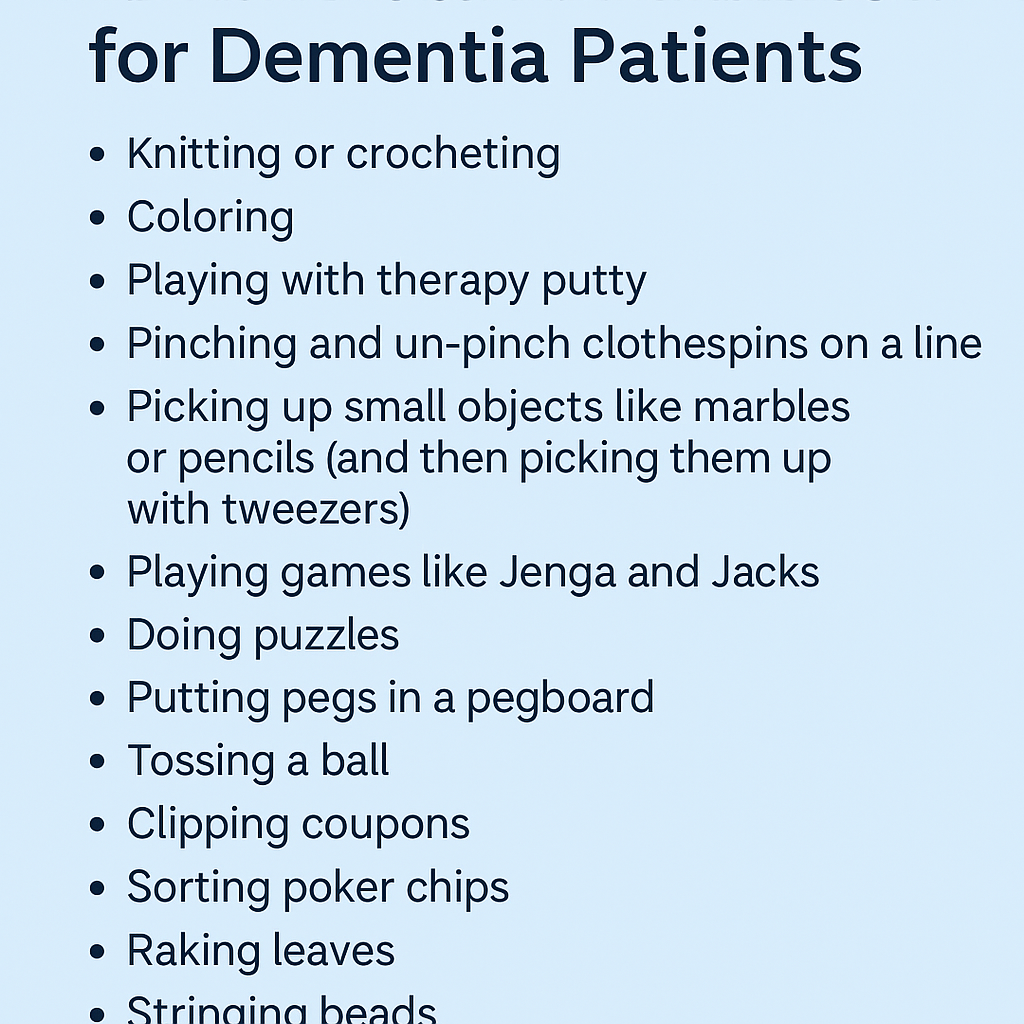Table of Contents
ToggleEngaging Fine Motor Skills Activities for Dementia Patients
Stimulating fine motor skills can greatly benefit dementia patients by enhancing coordination, focus, and independence. Here are some effective and enjoyable activities to support their motor development:
- Knitting or crocheting simple patterns
- Coloring with crayons or colored pencils
- Using therapy putty to squeeze, stretch, or roll
- clipping clothespins along a string
- Picking up small objects like marbles or pencils, or using tweezers for added challenge
- Playing hand-eye coordination games such as Jenga or Jacks
- Completing jigsaw puzzles
- Inserting pegs into a pegboard
- Tossing and catching a lightweight ball
- Cutting and sorting coupons
- Arranging poker chips by color or size
- Light yard work like raking leaves
- Stringing large beads onto yarn or string
- Participating in simple gardening tasks like planting or watering
- Folding towels and laundry
- Playing classic games like horseshoes
These activities not only encourage dexterity but also provide a sense of accomplishment and joy in daily life.
1. Knitting or Crocheting
Example: Creating a simple scarf using thick yarn and large needles.
Summary: Encourages hand coordination and concentration while offering a calming, repetitive motion.
2. Coloring
Example: Using crayons or colored pencils to fill in adult coloring books with floral or scenic designs.
Summary: Boosts creativity and focus while improving hand control.
3. Therapy Putty Exercises
Example: Rolling, squeezing, or stretching soft therapy putty.
Summary: Strengthens hand muscles and relieves stress through tactile stimulation.
4. Clothespin Activity
Example: Pinching and placing clothespins on a line or container edge.
Summary: Improves grip strength and finger movement control.
5. Picking Up Small Objects
Example: Collecting marbles or buttons from a table or using tweezers to pick them up.
Summary: Enhances finger dexterity and hand-eye coordination.
6. Playing Jenga or Jacks
Example: Removing wooden blocks from a Jenga tower without knocking it over.
Summary: Sharpens fine motor skills, attention, and steady hand movements.
7. Doing Puzzles
Example: Completing a 20- to 50-piece puzzle with large, easy-to-grip pieces.
Summary: Promotes problem-solving and finger coordination.
8. Pegboard Activities
Example: Inserting colored pegs into matching holes on a board.
Summary: Supports pattern recognition and precise hand movements.
9. Tossing a Ball
Example: Tossing and catching a soft foam ball with a partner.
Summary: Enhances coordination, timing, and reaction skills.
10. Clipping Coupons
Example: Cutting out coupons from newspapers with safety scissors.
Summary: Encourages hand control and visual focus during everyday tasks.
11. Sorting Poker Chips
Example: Separating poker chips by color or size and stacking them.
Summary: Develops sorting skills and finger strength.
12. Raking Leaves
Example: Using a lightweight rake to gather leaves in a small area.
Summary: Combines light physical activity with hand and arm movement.
13. Stringing Beads
Example: Placing large beads onto a string to make a necklace.
Summary: Strengthens finger coordination and concentration.
14. Simple Gardening Tasks
Example: Planting small flowers or watering plants with a spray bottle.
Summary: Encourages connection to nature while exercising fine motor skills.
15. Folding Laundry
Example: Folding towels or matching socks into pairs.
Summary: Reinforces memory patterns and hand coordination.
16. Playing Horseshoes
Example: Tossing plastic horseshoes toward a target in a garden or hallway.
Summary: Improves aim and grip strength in a fun and engaging way.
✅ Conclusion
Engaging dementia patients in simple fine motor activities and interactive games plays a vital role in maintaining their physical and cognitive well-being. From coloring and sorting objects to playing Jenga or tossing a ball, these activities not only help improve coordination and focus but also provide emotional comfort and a sense of purpose. With daily practice and encouragement, such meaningful tasks can significantly enhance their quality of life and overall happiness.
FAQs: Activities for Dementia Sufferers
1. What are the best daily activities for dementia sufferers?
Gentle activities like coloring, folding laundry, light gardening, and sorting objects help dementia sufferers stay engaged and feel purposeful.
2. Why are fine motor skill activities important for dementia patients?
They help improve hand-eye coordination, reduce anxiety, and maintain independence in daily tasks.
3. Can dementia patients still enjoy hobbies?
Yes, many can enjoy simplified versions of their favorite hobbies, such as knitting, painting, or puzzle-solving, with proper guidance.
4. Are physical activities safe for people with dementia?
Light physical activities like tossing a softball, walking in the garden, or stretching are generally safe and promote mental wellness.
5. How often should dementia patients do activities?
Short, consistent sessions—about 20–30 minutes daily—are ideal to maintain focus and avoid fatigue.
FAQs: Games for Dementia Patients
1. What types of games are suitable for dementia patients?
Simple, familiar games like Jenga, bingo, card matching, and puzzles work well as they encourage memory and coordination.
2. Can games help slow dementia progression?
While games can’t cure dementia, they can help stimulate the brain, slow cognitive decline, and improve mood.
3. Are digital games appropriate for dementia patients?
Yes, some dementia-friendly apps and tablet games offer memory exercises, coloring activities, or music games designed for older adults.
4. How do games benefit dementia patients emotionally?
Playing games can boost confidence, reduce stress, and create joyful social moments with caregivers or loved ones.
5. Is group play beneficial for dementia patients?
Absolutely! Group games promote interaction, prevent isolation, and create a sense of belonging.
